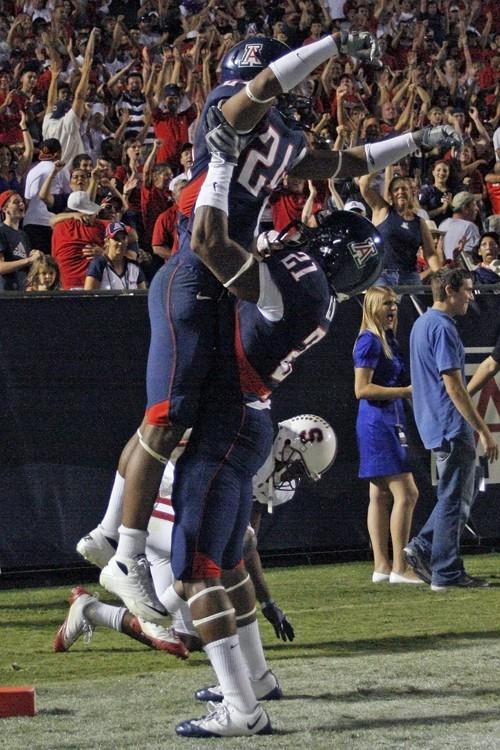Arizona football is relevant again, and it’s bursting onto the scene in a big way. The Wildcats are ranked No. 20 in the Bowl Championship Series and are ranked in the AP Poll (No. 23) for the first time in nine years.
It’s been soap opera-esque in Tucson so far, as Arizona has battled through a quarterback competition and more injuries and any team could realistically expect. Here are five reasons why the Wildcats have been able to battle through adversity and race out to one of its best starts in school history.
1. Team chemistry
They’ve only played seven games, but the Wildcats have had to go through a lot. First, there was the departure of senior leaders Willie Tuitama and Mike Thomas, then there was the fight between Nick Foles and Matt Scott to see who would replace Tuitama at quarterback. Tight end Rob Gronkowski had to undergo season-ending back surgery, and running back Nic Grigsby got hurt. Then the team got smacked at Iowa, and, of course, there was the ball that bounced off of wide receiver Delashaun Dean’s foot and/or the ground into a Washington defender’s hands.
Think about all those things that went wrong, and then think about the snowball effect that each event could have had. What if both quarterbacks failed? What if nobody stepped up to help replace the production of Gronkowski, Grigsby or even defensive end Brooks Reed? What if the team was so shell-shocked after losing those two tough games that it couldn’t recover?
If any of those questions were answered negatively, it would lead to the team giving up in some fashion. But each and every time something went wrong, the team got stronger as a singular unit and found a way to bounce back. Foles stepped up as quarterback, Greg Nwoko stepped up as a running back option, Juron Criner and David Roberts have become dependable receiving options, and after losses to Iowa and Washington, the team stepped up to beat Oregon State and Stanford.
2. Nick Foles
There’s a reason the guy gets so much press — he’s been that good.
Try and realistically wrap your mind around this journey that his career has taken over the past few years: he has his heart set on Arizona State after high school, but after a coaching change he decides to attend Michigan State. He then transfers to Arizona where he is told he’ll be able to compete for the starting job, but will likely be behind Matt Scott. Foles then outplays Scott in spring and summer scrimmages, but is slated as the backup to start the season.
Then he is given a chance to start in the fourth game of the season and not only does well, but leads the team to a 3-1 record and leads the entire country with a 72.3 completion percentage.
Yeah, pretty crazy. Arizona football is in good hands for the next few years as long as Foles can stay healthy.
3. Offensive line play
Nobody ever talks about or notices the offensive line unless it’s having problems, so it’s a good thing that nobody in the Zona Zoo has uttered a single sentence about the big-uglies up front this season.
The offensive line coach Bill Bedenbaugh has done a truly outstanding job, managing injuries and position changes without a hitch. The main reason that the offense leads the Pacific 10 Conference in yards per game is because the offensive line gives Foles so much time to throw and the unit has been so physically dominant at run-blocking.
Since it’s difficult to measure success of the offensive line with individual statistics, consider this: Of the 191 times Foles has attempted a pass, he has only been sacked twice.
4. Depth at the skill positions
The injury to Gronkowski has seriously hurt this team, especially in the red zone, (side note: you could legitimately make the argument that if Gronkowski was playing this year and was at full strength that Arizona would have capitalized on its red zone opportunities against Iowa and Washington and be 7-0), but his absence has given other players an opportunity to step up in the receiving game.
Sophomores Criner, Roberts and David Douglas have been so reliable that they’ve teamed with Turner and Dean to give Arizona a realistic reason to go four- or five-wide on any down.
And then there have been the other injuries, like the knee injury to receiver William “”Bug”” Wright or the shoulder injury to running back Grigsby. When healthy, Wright was the third receiver on the team before Criner, Douglas and Roberts and when he returns to full strength Arizona has six legitimate receivers to rotate.
Grigsby’s injury has given players like Keola Antolin and Nwoko considerable carries and they’ve all succeeded, and even senior Nick Booth as made plays when the Wildcats needed them.
5. Good coaching
Arizona’s coaches have adapted to and optimized their players talent this season, much more so than in years past. The position coaches like Bedenbaugh, Jeff Hammerschmidt (defensive ends), Seth Littrell (running backs), Dave Nichol and Garret Chachere (outside and inside receivers coaches, respectively) have done such a good job that players that were listed as third-string at the beginning of the season have been able to sub-in this year because of an injury without a hitch.
The offensive and defensive coordinators Sonny Dykes and Mark Stoops have called plays that fit their players perfectly. All of those quick screens enable Foles to use his strong arm and get the ball out quickly to his shifty receivers, turning 1-2 yard throws into 7-10 yard gains every time.
On defense, Stoops has been able to dial up blitzes with his quicker-than-normal linebackers and effectively mixed man and zone coverages to give players like Trevin Wade the opportunity to grab interceptions.









